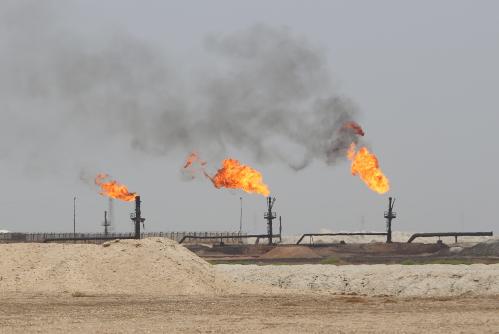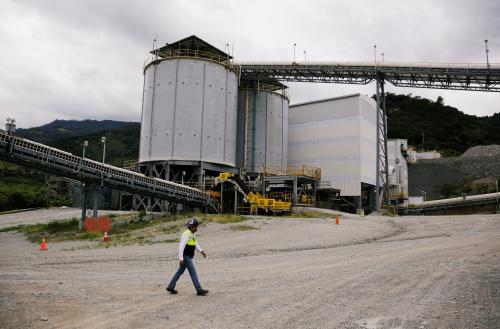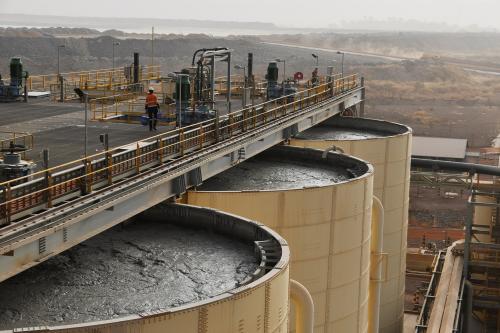This blog is the third in a series of posts surrounding the launch of the new Leveraging Transparency to Reduce Corruption (LTRC) report, “The TAP-Plus Approach to Anti-Corruption in the Natural Resource Value Chain.” You can read the other posts in the series here.
In a matter of hours on Nov. 16, 2017, the bank account of Angola’s state-owned oil company, Sonangol, was drained. At the start of the day, the account contained $57 million; when it was over, only $309 remained. That same day, the head of the company, Isabel dos Santos—the daughter of the nation’s former president—was fired.
The money that was so rapidly transferred from Sonangol’s coffers did not, as many suspected, go directly into dos Santos’ pockets. Instead, it went to a consulting company run by one of her close allies, though many questioned whether much of the proceeds ultimately benefited her.
The late 2017 assault on Sonangol’s bank account was merely one of many suspicious financial transactions involving dos Santos. Over a 20-year period, she and her family conducted what may prove to be a master class in corruption along the natural resource value chain (NRVC), a fact pattern uncovered this year by the International Consortium of Investigative Journalists in its “Luanda Leaks” exposé.
With its vast offshore oil reserves and the fourth largest diamond mine in the world, Angola’s resource riches have the potential to transform the country. Instead, it is has emerged as a prime example of the so-called resource curse—the vast array of societal, economic, and political woes that sometimes proliferate alongside a sudden increase in natural resource-based wealth.
Economic inequality is rife in Angola. Today, despite being one of the globe’s top 15 oil-exporting nations, almost 50% of Angola’s population lives on less than $2 per day. Yet, in 2018, the nation’s capital city of Luanda was one of the 10 most-expensive cities for expatriates to live in, on par with Tokyo and Zurich.
To the extent that the Angolan government were able to address pervasive poverty, it would only be able to from a budget disproportionately dependent on resource wealth: Oil accounts for 75% of government revenue.
When dos Santos allegedly went on a two-decade-long campaign siphoning off the nation’s wealth for her personal benefit, she became a key player in the kind of scheme that undermines positive development outcomes in resource-rich countries. (Dos Santos is currently under an ongoing criminal investigation in Angola but has not, as yet, been convicted of wrongdoing.)
Many studies have found a positive correlation between economic dependence on natural resources and increased corruption, and controlling corruption is a key mechanism for mitigating the resource curse. But any effort to address corruption like that seemingly perpetrated by dos Santos must begin by understanding types of corruption and how and where they occur.
To do so, it is important to analyze corruption risks along the NRVC. The NRVC framework describes the sequence of activities related to resource extraction that are necessary for a country’s population to benefit from its resource endowments. However, each of these activities is accompanied by corruption risks. Our understanding of corruption along the NRVC is largely derived from an extensive 2016 OECD study; an abbreviated version is presented here:
| NRVC Steps | Types of Risk |
| 1. Consent of Affected Communities |
|
| 2. Contracts and Licenses |
|
| 3. Extraction and Production |
|
| 4. Revenue Collection and Taxation |
|
| 5. Revenue Management, Expenditure, and Investment |
|
| Source: Derived from OECD 2016 | |
The Luanda Leaks scandal brings to life many of the risks along the NRVC.
NRVC Steps One and Two: Consent and Contracting
The first step in the NRVC is consent, or the decision to extract. In well-regulated, effective states, this decision can involve consulting affected communities and obtaining their buy-in before contracts are signed. In Angola, where mining stretches back to the colonial era, no consent processes exist, and consultation mechanisms are weak.
After the government controlled by José Eduardo dos Santos, Isabel’s father, captured the nation’s largest diamond mines in the midst of a civil war, it created the Angolan Selling Corporation (ASCORP) in 1999, one of a set of intertwined state-owned enterprises with monopoly rights to diamond extraction. While the Angolan state held a majority stake in ASCORP, the remaining 49 percent of its shares were split between three Israeli diamond merchants and a newly set up Gibraltar investment company called Trans Africa Investment Services.
Trans Africa’s owner was none other than the then 25-year-old Isabel and her mother.
NRVC Steps Three and Four: Production and Revenue Collection
In contrast to the diamond business, dos Santos was not given an ownership stake in Sonangol, the state oil company, which was established in 1976. Throughout the past decade, she nonetheless became increasingly involved in the Angolan oil value chain. In 2015, in the wake of a global collapse in oil prices, companies she owned or controlled were given lucrative contracts to work with Sonangol, though they often did not have the expertise to perform the services for which they were hired. These raise characteristic NRVC Step Three concerns, where procurement and services contracts are prime targets for corrupt practices and often involve politically connected people like dos Santos.
By the next year, dos Santos was more than a contractor benefiting from Sonangol’s riches. That year her father put her in charge of the company. Slightly more than a year later, Jose Eduardo dos Santos stepped down as president of Angola. Shortly thereafter, his daughter was fired.
Isabel dos Santos’ involvement in diamond production did not stop with her ownership stake–it eventually seems to have brought her to involvement in steps three and four of the value chain. In 2012, a bank partially owned by dos Santos helped finance the purchase of a controlling interest in luxury jewelry maker De Grisogono by Sodiam, one of Angola’s government-controlled diamond companies. The loan was paid back at 9% interest with a guarantee from the Angolan treasury. Furthermore, although almost all of the purchase price was paid by Sodiam, half of the ownership stake in the jeweler went to a company controlled by dos Santos and her husband. In one single transaction, dos Santos appears to have managed to siphon revenue in two ways: getting paid a high interest rate for the loan and taking a stake in the jeweler far exceeding her investment contribution.
Furthermore, it was alleged that dos Santos and her husband were able to buy diamonds from the state at below market rates. If diamonds were indeed sold at a below market price, it would represent what the OECD calls “mispricing in commodity trading”—the circumvention of usual commodity trading procedures by selling the minerals at a cut rate for dos Santos’ personal benefit.
This month, an Angolan civil court labeled the Sodiam venture “fraudulent” and an “opportunity” for dos Santos and her husband to control De Grisogono—and not “an opportunity for Angolans as it was made to be believed.” If true, these activities are classic examples of corruption at NRVC Step Four—the Revenue Collection step—where resource revenues are corruptly diverted or underreported, thereby depriving a nation of vital tax revenues that can be spent for the good of the citizenry.
NRVC Step Five: Revenue Expenditure
Although dos Santos allegedly engaged in a multitude of complex, shadowy transactions in the earlier steps of the value chain, some of her largest windfalls came in the form of lucrative government contracts and substantial loans for her companies enabled by Angola’s large resource revenue. These forms of suspect government spending appear to be characteristic of corruption at NRVC Step Five: the revenue expenditure phase. To take just one example, in a deal signed in 2015, two real estate companies owned by dos Santos, Urbinveste and Landscape, stood to receive $531 million to develop the Areia Branca area of Luanda. Dos Santos claims not to have profited from the deal, but expert review of the contracts has uncovered several questionable and atypical features, including $100 million for unspecified project costs. After the resignation of dos Santos’ father as president, his successor João Lourenço cancelled the contracts.
On top of these and other suspect contracts, dos Santos and her associates allegedly received over $1.1 billion in government loans that they have not serviced or repaid. In response to rising concerns over these loans, the Lourenço administration froze her assets in late 2019.
Lessons Learned
The scope of dos Santos’ involvement in the country’s oil and diamond businesses had been widely known for quite some time. However, the Luanda Leaks investigation radically altered the situation by raising the global visibility of alleged corrupt activities, including by uncovering dozens of shell companies that she and her husband had set up in countries ranging from Malta to Mauritius to Dubai to the United States. Now, many of her accounts have been seized. She has been forced to divest her ownership interests in many companies. And numerous criminal and civil investigations have been launched. However, “the bulk of her fortune is now outside Angola, much of it in tax and secrecy havens where it will be hard to pry loose.” These ex post efforts to address corruption in Angola, therefore, may have come too late for a country in the grip of financial austerity and sliding into recession—or worse.
By its very nature, corruption is a shadowy phenomenon that is difficult to study and harder to combat. The Luanda Leaks and other investigations play a key role in bringing such abuses into the light of day. The Brookings Leveraging Transparency to Reduce Corruption (LTRC) project seeks to do the same. By tracing and analyzing how this story manifested along the NRVC, scholars and practitioners of anti-corruption can better understand how to target interventions and policies that work to avoid similar abuses in the future.
The Brookings Institution is committed to quality, independence, and impact.
We are supported by a diverse array of funders. In line with our values and policies, each Brookings publication represents the sole views of its author(s).






Commentary
A master class in corruption: The Luanda Leaks across the natural resource value chain
July 23, 2020